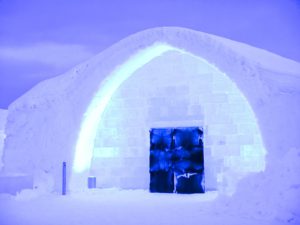Shelter
You cannot stay in the open to rest. GET OUT OF THE WIND! Look for natural shelter you can improve on, but AVOID the lee side (the side untouched or sheltered from wind) of cliffs where snow could drift and bury your shelter, or sites where falling rocks or avalanche is likely. Avoid snow laden trees – the weight could bring down frozen branches – unless the lower boughs are supported on the snow. There may be a space beneath the branch which will provide a ready-made shelter.
REMEMBER: Don’t block EVERY hole to keep out draughts. You MUST have ventilation, especially if burning a fire inside your shelter. Otherwise, you may asphyxiate.
Fire
Essential for polar survival. Fuel oils from wreckage can provide heat. Drain oils from sump and reservoir on to the ground as soon as possible – as it cools it will congeal and become impossible to drain. High octane fuel does not freeze so quickly – leave it in the tanks.
In the Antarctic and on the Arctic ice, seal and bird fat are the only other fuel sources. On coasts driftwood can sometimes be collected. Greenlanders used to build homes from timber which drifted across the Arctic from Siberian rivers.
In the tundra, low, spreading, willow can be found. Birch scrub and juniper also grow beyond the forests. Birch bark makes excellent kindling – the wood is oily. Feather a branch and it will burn even when wet.
Casiope is another low spreading heather-like plant that Eskimos use for fuel. Evergreen, with tiny leaves and white ball-shaped flowers, and only 4 – 12 in (10 – 30 cm) high. It contains so much resin that, it too, burns when wet.
 Casiope
Casiope
Arctic Health
Frostbite, hypothermia and snow blindness are the main hazards to your health. But efforts to keep warm with no ventilation can lead to a lack of oxygen and carbon monoxide poisoning.
In polar conditions, it is easy to withdraw from reality, layered in clothing and with the head wrapped in a hood. Thinking can become sluggish and obvious things overlooked. Keep “switched on”. Forms of entertainment, if available, such as cards, magazines or even writing will keep the mind active and engaged.
Keep active but avoid fatigue and conserve energy for useful tasks. Sleep as much as possible – the cold will wake you before you freeze unless you are completely exhausted and cannot regenerate the heat you lose to the air.
Don’t let the cold demoralize you. Think up ways to improve the shelter, how to make a better pair of gloves, or improve your tools, for instance. Exercise fingers and toes to improve circulation.
Don’t put off defecation – constipation is often brought on that way. Do try to time it conveniently before leaving your shelter, so that you can take waste out with you.
Avoiding Frost Bite
- Wrinkle face to stop stiff patches forming, pulling muscles in every direction. Exercise hands.
- Watch yourself and others for patches of waxy, reddening or blackened skin, especially on faces, ears and hands.
- AVOID tight clothing, which will reduce circulation
- Dress inside warmth of sleeping bag (if you have one).
- Never go out without adequate clothing – however briefly. Avoid getting clothing wet, through sweat or water. Dry it as soon as possible if this happens.
- Knock snow off before entering shelter, or leave outer clothing at entrance. Snow will melt in warmth giving you more clothing to dry.
- Wear gloves and keep them dry. NEVER touch metal with bare hands.
- AVOID spilling oil or gas on bare flesh. In sub-zero temperatures it will freeze almost at once and does even more damage than water of its lower freezing point.
- Be especially careful if you have been working hard and are fatigued. If you are sick – REST.
